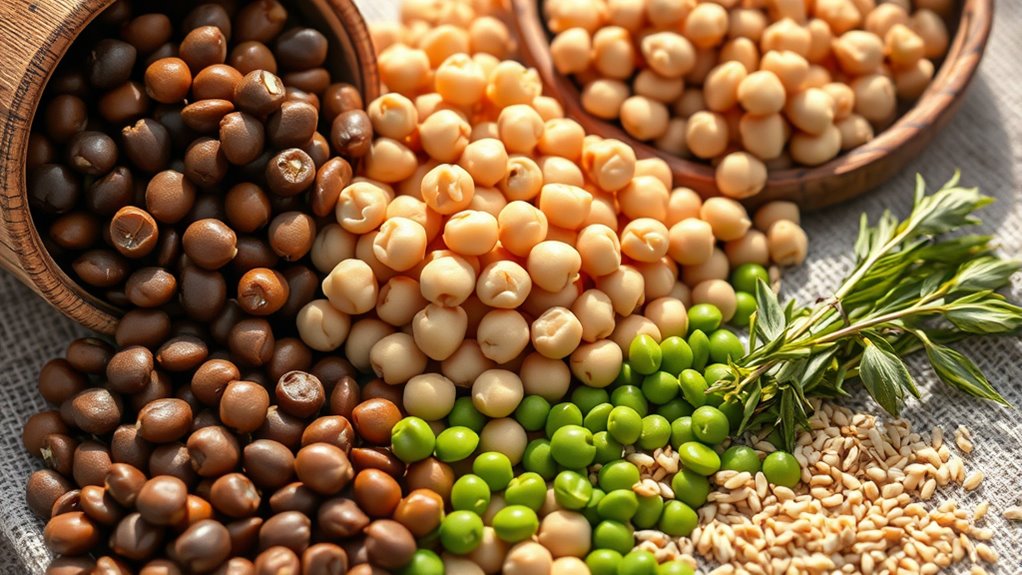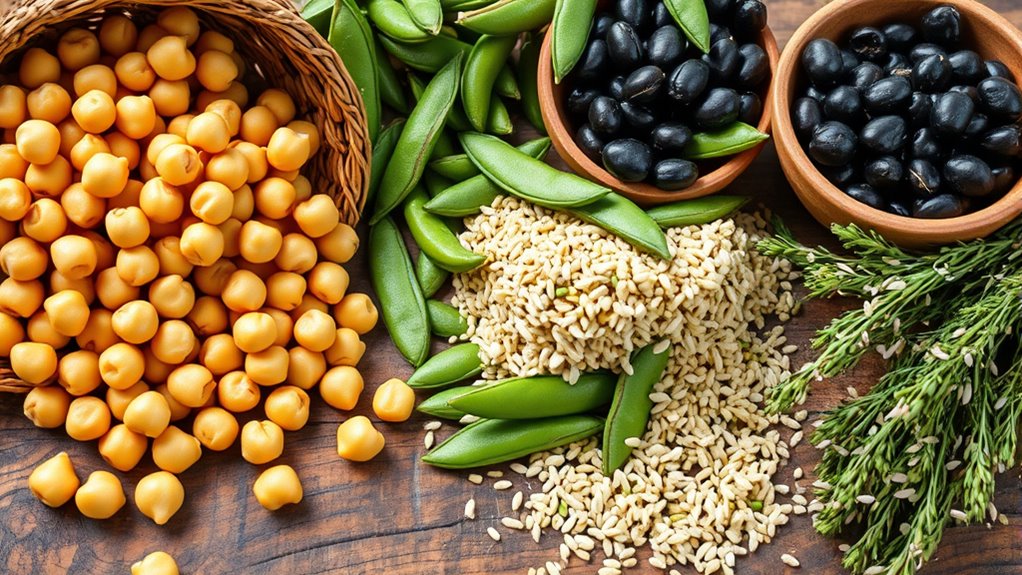To achieve balanced nutrition with plant-based proteins, include a variety of sources like legumes (lentils, chickpeas), soy products (tofu, tempeh), nuts, seeds (chia, hemp), and whole grains (quinoa). These foods provide essential amino acids, fiber, vitamins, and minerals, supporting overall health and energy needs. Combining different plant proteins helps guarantee you get all crucial nutrients. Keep exploring these options to help build a well-rounded, plant-focused diet tailored to your needs.
Key Takeaways
- Legumes like lentils, chickpeas, and beans are rich in protein, fiber, vitamins, and minerals, supporting overall nutrition.
- Soy-based products such as tofu, tempeh, and soy milk offer complete proteins that mimic animal meat textures and flavors.
- Whole grains like quinoa and buckwheat provide plant-based protein along with complex carbohydrates for sustained energy.
- Nuts and seeds, including chia, flaxseed, and hemp seeds, contribute healthy fats and protein, adding variety to a balanced diet.
- Combining different plant sources ensures a complete amino acid profile for comprehensive, plant-based nutrition.

Plant-based protein sources are becoming increasingly popular as more people seek nutritious and sustainable alternatives to animal products. If you’re looking to diversify your diet, you’ll find plenty of options beyond traditional meats. One of the most accessible and versatile choices is soy alternatives, which include products like tofu, tempeh, and soy milk. These are rich in complete proteins, meaning they contain all essential amino acids your body needs. Incorporating soy-based options can help you meet your daily protein requirements while keeping your meals plant-centered. However, soy isn’t your only option. Legume varieties, such as lentils, chickpeas, black beans, and kidney beans, are excellent sources of protein as well. They’re also packed with fiber, vitamins, and minerals, making them a wholesome addition to your meals. Legumes are incredibly versatile—you can add them to salads, stews, or blend them into spreads and dips. Their affordability and long shelf life make them a practical choice for regular consumption.
Expanding your intake of legume varieties not only boosts your protein intake but also supports digestive health due to their high fiber content. Plus, they’re easy to prepare and adapt to various cuisines, from spicy Indian curries to hearty Mediterranean stews. Many legumes are also a good source of complex carbohydrates, helping you stay energized throughout the day. If you’re exploring soy alternatives, you might also consider products derived from soy protein isolates or concentrates, which are used in many plant-based meat substitutes. These products often mimic the texture and flavor of animal meat, making them appealing options for those transitioning to a plant-based diet or simply looking to reduce meat consumption.
In addition to soy and legumes, other plant-based protein sources can round out your nutrition. Nuts and seeds, such as chia, flaxseed, and hemp seeds, contain decent amounts of protein and healthy fats. Whole grains like quinoa and buckwheat also contribute to your daily protein intake, especially when combined with legumes. The key to achieving balanced nutrition is variety—you want to include multiple sources of plant proteins to ensure you get a broad spectrum of nutrients. By exploring different soy alternatives and legume varieties, you set yourself up for a sustainable, nutritious diet that supports your health and aligns with your values. Whether you’re a seasoned vegetarian or just incorporating more plant-based meals, diversifying your protein sources ensures you enjoy a delicious, well-rounded diet every day.
Frequently Asked Questions
How Do Plant Proteins Compare to Animal Proteins in Amino Acid Profiles?
Plant proteins often have lower amino acid completeness compared to animal proteins, which means they may lack some essential amino acids. However, by eating a variety of plant-based sources, you can improve the protein quality comparison. Combining beans, grains, and nuts ensures you get all essential amino acids, making your plant-based diet nutritionally balanced. So, with mindful choices, plant proteins can meet your amino acid needs effectively.
Are There Specific Plant Proteins Suitable for Children and Teenagers?
You might wonder if specific plant proteins suit children and teenagers. While some worry about plant protein allergies or taste preferences, many options like lentils, chickpeas, and tofu are suitable and nutritious. These sources can support growth and development when integrated thoughtfully into meals. Always check for allergies and involve kids in choosing flavors they enjoy, making plant-based eating both safe and appealing for young people.
Can Plant-Based Proteins Fully Replace Animal Proteins in All Diets?
Plant-based proteins can replace animal proteins in many diets, but not always fully. You should consider plant protein varieties like beans, lentils, and soy, which offer essential amino acids. While they often have a lower environmental impact of plant proteins compared to animal sources, some nutrients might need supplementation. It’s key to diversify your plant proteins to meet all nutritional needs and support sustainability.
What Are the Best Plant Protein Sources for Athletes and Active Individuals?
Did you know plant-based proteins can match animal sources in muscle building? As an athlete, you should focus on organic plant sources like lentils, chickpeas, and quinoa. Plant protein blends, combining peas, rice, and hemp, offer complete amino acids for ideal recovery. These options are nutrient-rich, easy to digest, and perfect for active lifestyles, helping you stay energized and support muscle growth naturally.
How Can I Ensure Adequate Protein Intake on a Vegan or Vegetarian Diet?
To guarantee adequate protein intake on a vegan or vegetarian diet, focus on incorporating fortified foods and practicing protein combining. Include a variety of legumes, grains, nuts, and seeds in your meals, and pair complementary proteins like rice and beans to boost amino acid profiles. Fortified plant milks and cereals also help fill nutritional gaps. Staying consistent with these strategies ensures you meet your protein needs effectively.
Conclusion
By incorporating plant-based protein sources into your diet, you’re building a sturdy bridge to balanced nutrition. These foods are like vibrant puzzle pieces fitting perfectly into your health picture, providing essential nutrients without the heaviness of animal products. Embrace the variety and let your plate be a colorful mosaic of flavors and benefits. Remember, every plant-based choice you make plants the seeds for a healthier, more sustainable future—one delicious bite at a time.









